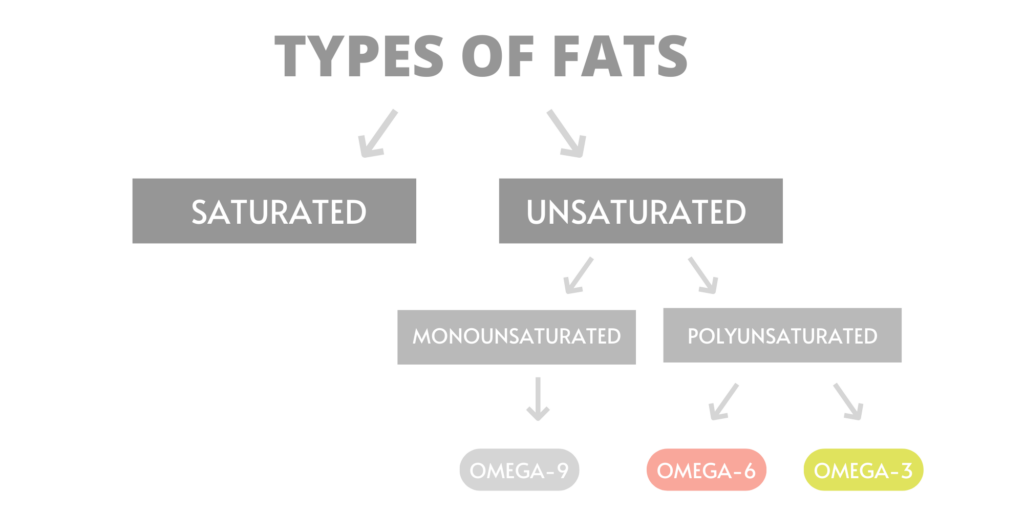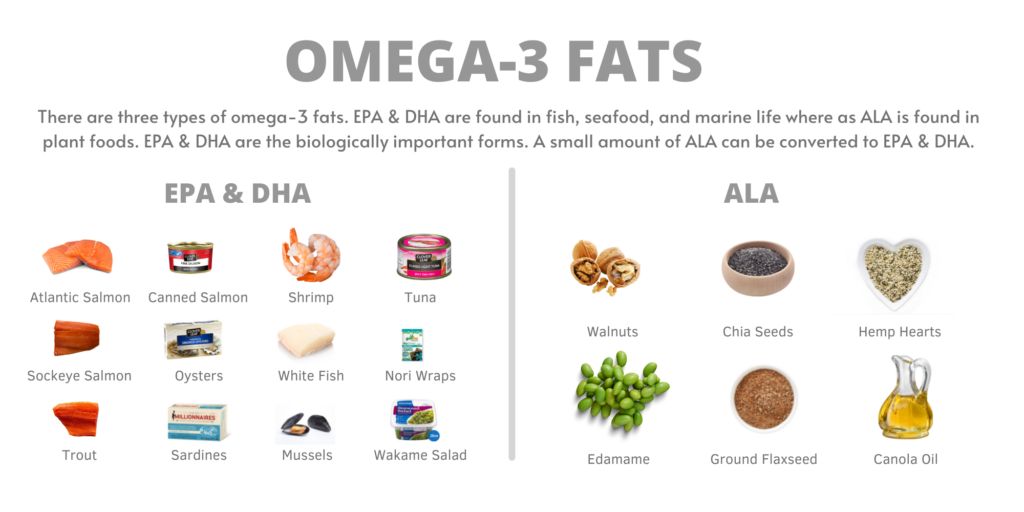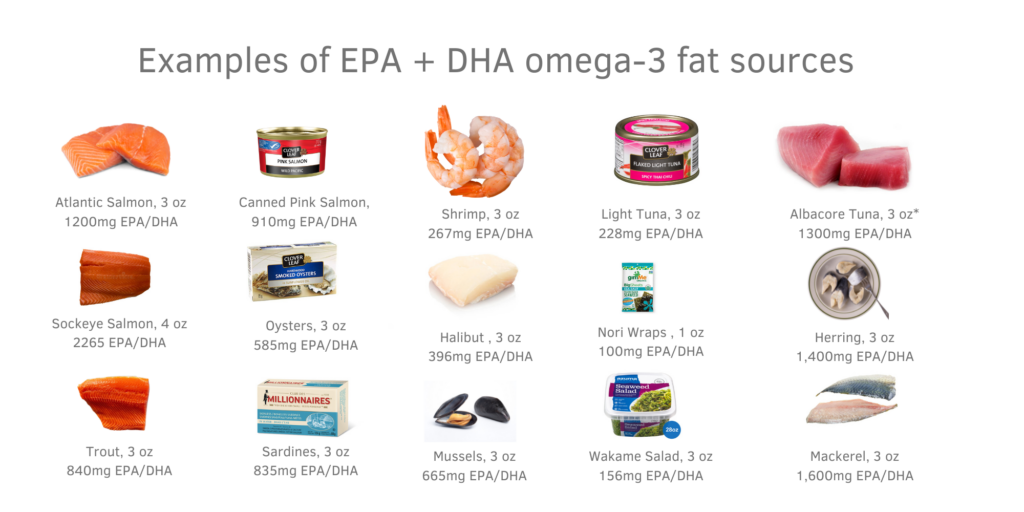Dietitian’s guide to Omega-3 fats
Nutrition Month 2022 is centered on the key ingredients for a healthier tomorrow, which includes building your health literacy. This Nutrition month, we’ve partnered with of Vitality Nutrition‘s Registered Dietitian Courtney Berg to build your food literacy skills. Click here to meet Courtney.
Fats are one of the three macronutrients, alongside protein and carbohydrate, that the body requires for a variety of functions and processes. Omega-3 fats are a small subset of the total fats we can get from the foods we eat, yet they’re one of the most impactful for our overall health and well-being.
What are omega-3 fats?
Fats can be broken down into two main categories: saturated and unsaturated. As shown below, omega-3 fats are a subcategory of polyunsaturated fatty acids.

Omega-3 fats are of particular interest because they are an important component of cell membranes and support brain health, immune function, vision, heart health, and hormone production. These fats have been researched to be anti-inflammatory and can protect against a wide range of diseases.
There are three main types of omega-3 fats: alpha-linolenic acid (ALA), eicosapentaenoic acid (EPA), and docosahexaenoic acid (DHA). Of the three forms, the two of greatest interest are EPA and DHA because of their role in growth, development, and disease prevention.
- EPA & DHA are found in marine-life including fatty fish, seafood, and algae. EPA is shown to reduce inflammation and DHA is a structural component in cell membranes, particularly in nerve cells in your brain and eyes. Both types are considered the biologically important forms of omega 3.
- ALA is found in plant-based fats like flaxseeds, chia seeds, hemp hearts, and walnuts. ALA is considered an essential fat that the body can convert to EPA and DHA, however, the conversion is inefficient and cannot be relied upon as a sole source of EPA and DHA.

Who benefits from omega-3s?
While consumption of omega-3 rich fat sources is an important consideration for all stages of the life cycle, there are particular populations who may benefit from intentional sourcing:
- Pregnancy: Omega-3s, particularity from DHA, are vital to the development of the fetal brain and retina. Health Canada recommends that pregnant women prioritize omega-3 food sources.
- Breastfeeding: Developmentally important DHA omega-3s are passed to the infants through breast milk and it is recommended that breastfeeding mothers consume 1-2 servings of fish per week to guarantee a sufficient amount of DHA in breast milk.
- Infants and children: Adequate consumption of omega-3 acids has been shown to prevent deficits in development.
- Heart disease: Overall, research indicates that consuming fish and other types of seafood as part of a balanced diet promotes heart health. In some cases, intakes of up to 1,000 to 4,000 mg per day is recommended for people with existing coronary heart disease or to decrease elevated triglycerides.
- Athletes: Nutritional strategies and supplements that increase omega-3 fat consumption can result in optimal training gains and enhanced recovery in athletes.
Additional information for conditions including reduced cancer risk, dementia, rheumatoid arthritis, depression, dry eye disease, ADHD, inflammatory bowel disease, and others can be found here.
How to optimize your omega-3 intake
The EPA and DHA forms of omega-3 fatty acids are considered beneficial but they are not deemed essential. For this reason, there are no established dietary reference intakes for EPA and DHA. While there is no recommended minimum intake, health authorities recommend consuming omega-3 rich food and/or supplement sources in varying doses for their health promoting properties.
1. Eat fatty fish or seafood two or more times per week
While there is no recommended intake of omega-3, a common recommendation is to eat fish two or more times per week as a protein source that contains beneficial EPA and DHA. Review the content of omega-3 in fish sources below:
What about the mercury content of fish? Some sources of fish have higher amounts of heavy metals like mercury. These fish include shark, orange roughy, swordfish, and ahi or albacore tuna. Light tuna or skipjack tuna are low in mercury. It is advised to consume no more than 2 servings per week of high mercury fish and avoid high mercury containing fish when pregnant.
2. Support your intake with plant-based omega-3
Small amounts of ALA is converted to the biologically important DHA and EPA forms. Adding plant-sources of omega-3s to your diet such as chia seeds, hemp hearts, ground flax, and walnuts can boost your omega-3 intake while providing other nutritional benefits like fibre, vitamins, and minerals!
Dietitian Tip: Try adding chia seeds to overnight oats, sprinkle flax into smoothies, add walnuts to a yogurt parfait, or sprinkle hemp hearts onto salads.
3. Reduce omega 6 fatty acids when possible
Experts recommend limiting omega-6 food sources when possible to optimize the benefits of the omega-3 fats you consume. This is because omega-6 fats compete for the same enzymatic pathway as health-promoting omega-3s! Additionally, omega-6 fats have been associated with increased markers of inflammation. Omega-6s are found in vegetable oils including sunflower oil, soybean oil, safflower oil, corn oil, and grapeseed oil. Restaurant meals, deep fried foods, commercial baking, and processed foods tend to be high in omega-6s because vegetable oils are often used in the production of these foods.
Dietitian Tip: Cook and bake with avocado oil, olive oil, coconut oil, or butter instead of omega-6s vegetable oils to optimize your omega 3 to 6 ratio.
4. Discuss omega-3 supplements with a healthcare professional
Omega-3 fish or algae supplements can be a source of EPA and DHA for those who don’t consume fish or individuals looking to further boost their omega-3 intake. Supplements may also be important for populations, like pregnant women, who benefit from EPA and DHA but don’t enjoy or regularly consume fish. Speak to a trusted healthcare provider, like a Registered Dietitian, to determine whether an omega-3 supplement would be beneficial for you.
In conclusion
Omega-3s are a type of fat that contribute to the growth and development of the brain and retina, play a role in reducing inflammatory biomarkers, and are protective against chronic diseases. Fatty fish and seafood are a key source of the biologically important form of omega-3s (ie. EPA and DHA). If you do not regularly consume fish, consider reaching out to a trusted healthcare provider to discuss whether you might benefit from sourcing omega-3 fats from a supplement.
Meet Courtney Berg, RD, B.Sc. Nutrition

About Courtney | Courtney Berg is a Registered Dietitian and completed her Bachelor’s Degree in Nutrition from the University of Saskatchewan in 2016. Her approach to nutrition continues to evolve as she learns and grows with her clients at Vitality Nutrition. However, a holistic approach remains the base of her philosophy with an emphasis on understanding how nutrition as well as sleep, mindset, exercise, and the environment work together to influence whole body health.
About Vitality Nutrition | Vitality Nutrition is a collective of Registered Dietitians and Nutritionists supporting clients in Saskatchewan and across Canada! We incorporate a unique and meaningful approach to food, fitness, and performance that empowers clients to build life-long habits and see lasting results.
